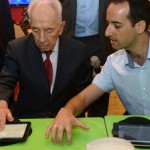If you or anyone you know are visually disabled or have a medical condition of the eye, you’ll definitely want to know about some incredible scientific advances in treatment made by scientists in Israel. In this piece, we’ll discuss five of the top ten from an article on the website israel21c.org. In part 2, we’ll tackle the remaining five.
- Implanted telescope for macular degeneration. A revolutionary, pea-sized telescope implant by Dr. Isaac Lipshitz, developed by Israel’s VisionCare Ophthalmic Technologies, improves eyesight in patients with end-stage age-related macular degeneration (AMD).The miniature telescope is implanted in one eye to enlarge central vision images over a wide area of the AMD-damaged retina. The other eye provides peripheral vision for mobility and orientation. In January 2014, the device is due to receive approval for Medicare and Medicaid reimbursement in the United States.
 UpSense keyboard. Israeli startup Inpris developed a mobile app offering the first fully gesture-based keyboard to enable people with visual impairment to type on tablets and smartphones using customizable gestures. The app also has a mode for those already proficient in Braille typing.
UpSense keyboard. Israeli startup Inpris developed a mobile app offering the first fully gesture-based keyboard to enable people with visual impairment to type on tablets and smartphones using customizable gestures. The app also has a mode for those already proficient in Braille typing.- OrCam. Created by Hebrew University Prof. Amnon Shashua, the OrCam attaches to eyeglasses and is wired to a portable computer in the wearer’s pocket. Using bone conduction technology, it “speaks” text (menus, street signs, grocery labels, newspapers) as well as bus numbers and other objects that the user points to. It can even recognize faces and monitor traffic lights.
Gestures such as shaking or waving “teach” the device to recognize images not already programmed into it. After three years of testing, OrCam is sold online in limited quantities for about $2,500 each. - Project RAY. This is the world’s first smartphone for people with visual disabilities. It debuted in Israel and launched earlier this year in the United States in collaboration with Qualcomm, Amazon, and T-Mobile.The device leverages advanced smartphone technologies (multiple sensors, cameras, compass and audio) and communication services (phone, messaging and cloud) to give users greater independence and accessibility to essential public digital services.
 Nano Retina. The company’s implantable artificial retina is activated by eyeglasses fitted with a laser energy source to transform light into neuron-stimulating electrical impulses. The technology could restore vision to people blinded by retinal diseases.
Nano Retina. The company’s implantable artificial retina is activated by eyeglasses fitted with a laser energy source to transform light into neuron-stimulating electrical impulses. The technology could restore vision to people blinded by retinal diseases.



